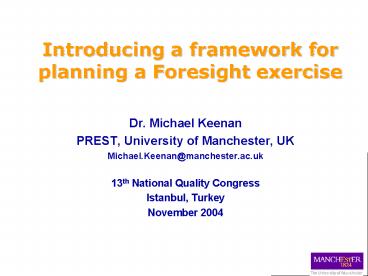Introducing a framework for planning a Foresight exercise - PowerPoint PPT Presentation
1 / 21
Title:
Introducing a framework for planning a Foresight exercise
Description:
Consideration of the various elements that need to be ... Policy transfer (bandwagon effects?) The 'Millennium Effect' Starting levels' for Foresight ... – PowerPoint PPT presentation
Number of Views:53
Avg rating:3.0/5.0
Title: Introducing a framework for planning a Foresight exercise
1
Introducing a framework for planning a Foresight
exercise
- Dr. Michael Keenan
- PREST, University of Manchester, UK
- Michael.Keenan_at_manchester.ac.uk
- 13th National Quality Congress
- Istanbul, Turkey
- November 2004
2
Outline
- Key characteristics of Foresight
- Consideration of the various elements that need
to be considered before embarking upon a
foresight exercise based upon guidelines
developed in the Handbook for Knowledge Society
Foresight (EFL, 2003)
3
Five essential characteristics
- Anticipation and projections of long-term
developments - Interactive and participative methods of debate
and analysis - Forging new social networks
- Elaboration of strategic visions based on a
shared sense of commitment - Implications for present-day decisions and actions
4
What does a Foresight exercise look like?
- Many shapes and sizes!
- Common aspects experts, panels, project team,
fixed budget and time, sponsor, reporting and
recommendations - Typical variations methodological
sophistication, degree of participation, budget
and time available, time horizon, coverage,
organisational configuration, etc.
5
Points to consider when planning a Foresight
exercise
- Rationales
- Objectives
- Orientation
- Level
- Review existing arrangements
- Time horizon
- Coverage
- Participation Consultation
- Raising Awareness Publicity
- Resources
- Methods to be used
- Organisation Management
- Outputs and Intervention
- Outcomes, Reflexivity, Renewal
- Determined
- through an
- iterative
- process
6
Rationales
- Escalating industrial and economic competition
- Increasing pressure on governmental spending
- Changing nature of knowledge production
- Emergence of new styles of policy-making
- Increasing desire for anticipatory intelligence
- Building advocacy coalitions
- Policy transfer (bandwagon effects?)
- The Millennium Effect
7
Starting levels for Foresight(Not mutually
exclusive)
- Territorial National (most visible),
Sub-national (regional, city-region /
municipality), Supranational (bilateral,
multilateral, International Organisation), Global - Domain economic, social, environmental,
technology, scientific discipline - Alternative starting points
- Flows (e.g. rivers, pollutants, people, traffic,
goods and services, etc.) - Networks (e.g. people, organisations,
infrastructures, etc.) - Markets (e.g. goods, services, labour)
8
Time horizon
- Typically between 5-30 years
- Should be beyond normal planning horizons
- Will be dependent upon things like the issues to
be considered, and the needs of strategy and
decision making
9
Examples of time horizon
10
Participation (1)
- Nature how are actors to be engaged in an
exercise? what will they be expected to do? - Extent who is to be involved?
- Frequency when will actors be invited to
participate?
11
Who should I get on board?
- This will depend upon
- The scope of your planned activities
- The social, economic and political culture
- Possible Early Targets
- Senior public officials
- Business spokespersons
- Senior scientists
- Other respected figures from civil society
- Ministers and other politicians
- Prospective sponsors
12
Possible objections
You cant predict the future Scientific
serendipity Fatalism Inertia Institutional
competition Disputes over the scope Proof of
concept Costs
Broad Philosophical
Practicalities Details
13
Resources
Finance
Cultural
Need to be thought about at every stage of a
Foresight exercise
Infrastructure
Political
Human Resources
Time
14
Overview of some common methods(Loveridge, 1996)
15
Foresight methods
- Important criteria for choosing methods
- Participation
- Desired Outputs
- Resources (esp. time, money, and expertise)
- Quantitative/Qualitative data requirements
- Time horizon
- Methodological competence (often key factor)
- Suitability for combining with other methods
(feeders and triangulation) - Suitability for visualising the results
16
Organisation and Management
- Some common organisational forms
- Steering Group
- Panels of Experts and Stakeholders
- Project Management Team
- Wider Pool of Participants
17
Outputs (1)
- Tangible and intangible products associated with
foresight - Must often be designed with intervention
strategy in mind (especially target audience and
outcomes desired) - Different methods produce different products
18
Outputs (2)
- Examples of tangible products include
- Scenarios and Visions
- Baseline and benchmarking studies
- Critical technology lists
- Products should be attractive and marketed
through, for example, reports, conferences, TV
and radio, newspapers and journals, school and
university curricula, etc.
19
Outputs (3)
- But a key output should be the process benefits
associated with TF, e.g. - Networking and resultant horizontal linkages
- Commitment to guiding visions
- Adoption of long-term thinking and Foresight
practices - Perhaps the most desirable outcome is a
Foresight Culture. - Difficult to achieve - should be a long-term aim
- Can be facilitated (in part) through training,
the production of methodological guides, and
demonstrators of Foresights benefits
20
Summary
- Scoping is a necessary step of a foresight
exercise, allowing a project plan to be drafted - This session has set out a framework with a
number of elements that need to be thought about
and addressed - The framework provides a starting point for you
to design and organise a foresight exercise
21
Questions and Comments?
- Dr. Michael Keenan
- PREST, University of Manchester, UK
- Michael.Keenan_at_manchester.ac.uk

